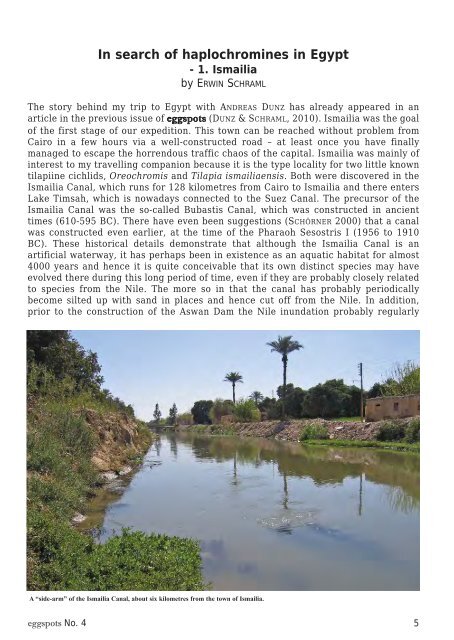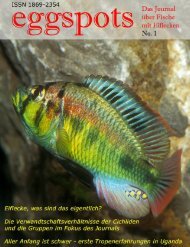Eggspots Elsewhere - Welt der Fische / World of Fishes
Eggspots Elsewhere - Welt der Fische / World of Fishes
Eggspots Elsewhere - Welt der Fische / World of Fishes
Create successful ePaper yourself
Turn your PDF publications into a flip-book with our unique Google optimized e-Paper software.
The story behind my trip to Egypt with ANDREAS DUNZ has already appeared in an<br />
article in the previous issue <strong>of</strong> eggspots (DUNZ & SCHRAML, 2010). Ismailia was the goal<br />
<strong>of</strong> the first stage <strong>of</strong> our expedition. This town can be reached without problem from<br />
Cairo in a few hours via a well-constructed road – at least once you have finally<br />
managed to escape the horrendous traffic chaos <strong>of</strong> the capital. Ismailia was mainly <strong>of</strong><br />
interest to my travelling companion because it is the type locality for two little known<br />
tilapiine cichlids, Oreochromis and Tilapia ismailiaensis. Both were discovered in the<br />
Ismailia Canal, which runs for 128 kilometres from Cairo to Ismailia and there enters<br />
Lake Timsah, which is nowadays connected to the Suez Canal. The precursor <strong>of</strong> the<br />
Ismailia Canal was the so-called Bubastis Canal, which was constructed in ancient<br />
times (610-595 BC). There have even been suggestions (SCHÖRNER 2000) that a canal<br />
was constructed even earlier, at the time <strong>of</strong> the Pharaoh Sesostris I (1956 to 1910<br />
BC). These historical details demonstrate that although the Ismailia Canal is an<br />
artificial waterway, it has perhaps been in existence as an aquatic habitat for almost<br />
4000 years and hence it is quite conceivable that its own distinct species may have<br />
evolved there during this long period <strong>of</strong> time, even if they are probably closely related<br />
to species from the Nile. The more so in that the canal has probably periodically<br />
become silted up with sand in places and hence cut <strong>of</strong>f from the Nile. In addition,<br />
prior to the construction <strong>of</strong> the Aswan Dam the Nile inundation probably regularly<br />
A “side-arm” <strong>of</strong> the Ismailia Canal, about six kilometres from the town <strong>of</strong> Ismailia.<br />
eggspots No. 4<br />
In search <strong>of</strong> haplochromines in Egypt<br />
- 1. Ismailia<br />
by ERWIN SCHRAML<br />
5




